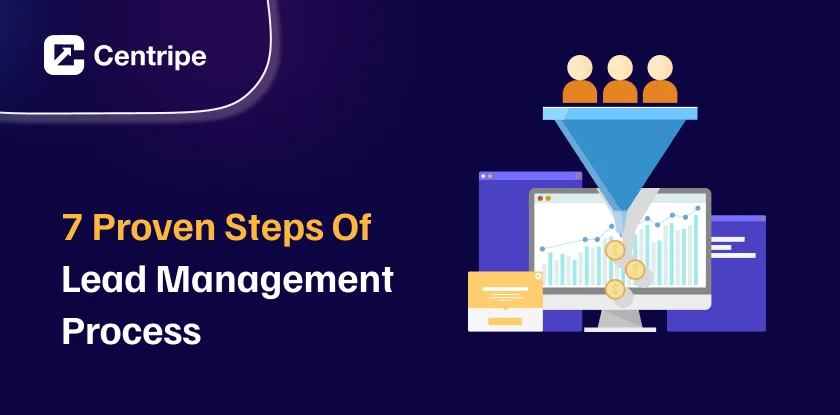The lead management process is where most businesses mess up.
As getting leads…. is the easy part.
The real challenge starts… after the lead shows interest. If you don’t have a strong process, those leads can quickly lose interest.
The lead management process guides interested prospects from their first contact to becoming ready-to-buy customers.
In fact, a study by Forbes found that 71% of internet leads disappear due to poor lead management.
Therefore, in the blog, we’ll break down simple lead management steps that will help turn curious visitors into happy customers.
What is the Lead Management Process?
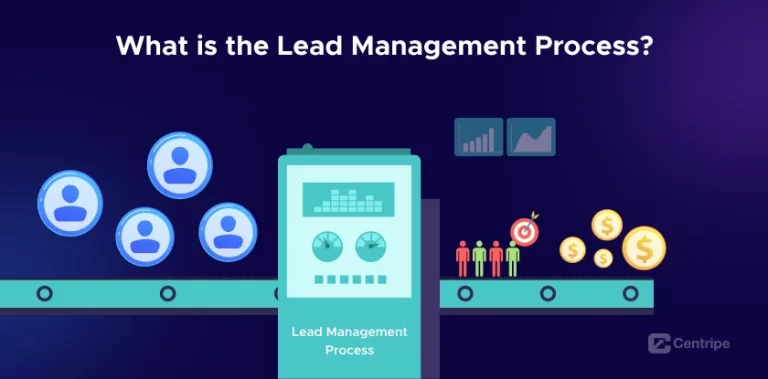
The lead management process is a step-by-step way to turn interested prospects into potential customers until they buy. It starts when someone first contacts you or visits your website and ends when they become your potential customers.
Why Does Your Business Need a Structured Lead Management Process?
Simply because without structure, even the best strategies fall apart.
A structured lead management process helps keep things clear, repeatable, and easy to scale.
It also helps you in:
- Helps your team work faster and smoothly.
- Keep track of every lead from the start.
- Follow up when they are most likely to respond.
- Share the right message based on the lead’s interest.
Let’s see what poorly structured Lead Management can cost you:
Businesses lose up to 71% of their leads just because they don’t follow up or forget to stay in touch.
That’s why it becomes important to have a structured lead management process.
The 7 Lead Management Processes That Drive Results
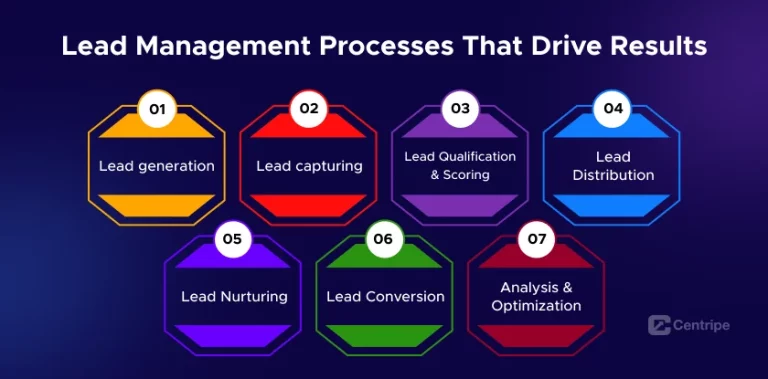
Here are 7 simple steps that make up a strong lead management process.
Stage 1: Lead generation
This is the first step, where potential customers are identified and attracted through various marketing channels.
Just adding a “Contact Us” form is not enough to attract customers. You need the right strategies to make them truly interested in your product. Let’s look at those proven Lead generation strategies:
Inbound strategy: It is the strategy where you let people find you on their own. You attract them by sharing useful information. Here’s how:
- Write helpful content like blogs, e-books, guides, or videos.
- Use lead magnets, like free tools or checklists, to give value and get contact information in return.
- Post on social media to connect with your audience.
- Host webinars or online events to teach and build trust.
Outbound strategy: It means you reach out to people first, even if they don’t know you yet. Here’s how:
- Call people directly by using cold calling.
- Sending emails and offers to promote your offer.
- Running ads on Google or social media to grab attention.
Real-World Example
Eaton, a global power company, was losing leads because their form was too long. So, they tried something simple. They started by asking just for a name and email. That’s it.
Later, when people came back, they asked them for more info. And the prospect turns into a customer. This small change helped them get 5,000+ quality leads and beat their goal by 276%.
Stage 2: Lead capturing
Now you know who is interested; hence, you can track and capture their information, which is our next step. Information such as name, email, company, and what they are looking for.
You can get this information through their sign-up forms or landing pages on your website. Every click, every download, every page visit tells you something about where they are in their journey.
Stage 3: Lead Qualification and Scoring
The harsh reality is that not every lead who visits your website is ready to buy. That’s where our next step helps, lead qualification helps us find out who’s really interested, so you can focus on who matters.
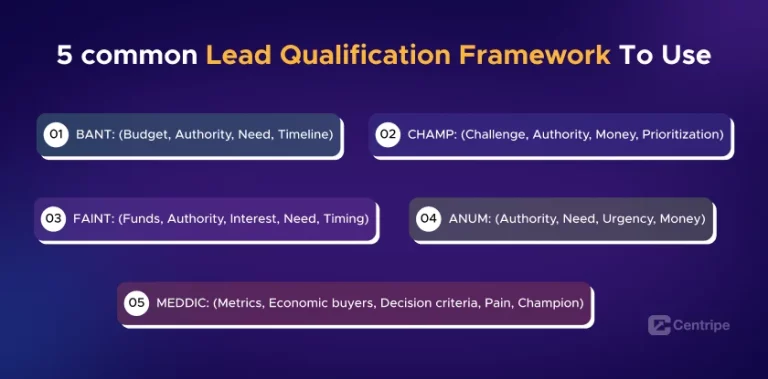
Below are the methods that will help you know which leads are worth investing in:
1. BANT: (Budget, Authority, Need, Timeline)
We all know BANT, It’s great if you are selling expensive products. It helps you check:
- Does the lead have the budget?
- Can they make the final decision?
- Do they actually need your product?
- Are they ready to buy soon?
2. CHAMP: (Challenge, Authority, Money, Prioritization)
CHAMP works well when your leads are not sure how your product helps. It looks at their problems and checks if your product can fix them.
3. FAINT: (Funds, Authority, Interest, Need, Timing)
The FAINT method is best for leads who are just starting to show interest. It checks whether the lead has money, is interested, and can make a decision.
4. ANUM: (Authority, Need, Urgency, Money)
Anum is great for B2B sales where the buying steps are not clear. Helps you in finding who makes the buying decision first, and then verifies if they need your product, and how soon they want it.
5. MEDDIC: (Metrics, Economic buyers, Decision criteria, Pain, Champion)
MEDDIC is best for B2B sales with expensive products. It’s a detailed system that works well when you have fewer, but more valuable leads.
Lead Scoring:
Lead qualification is incomplete without lead scoring. It is about giving points to leads who are interested based on their actions, like:
- What pages did they visit?
- What did they download?
- Their job titles and company Size.
Lead Scoring Model Example:
| Action | Points |
|---|---|
| Visit the pricing page | +10 |
| Download the case study | +5 |
| Opens 5+ emails | +3 |
| Company size 500+ | +15 |
| Job title contains ‘VP’ or ‘Director’ | +10 |
| Attended webinar | +8 |
| Requested demo | +25 |
Basic rules for the above example:
0-25 points: Keep nurturing
26-50 points: They’re marketing qualified (MQL)
– 51+ points: Time for sales to take over (SQL)
Note: In the table above, you add points for each lead based on what they do and who they are. When their total score hits around 20 points, the sales team knows it’s time to reach out.
Stage 4: Lead Distribution
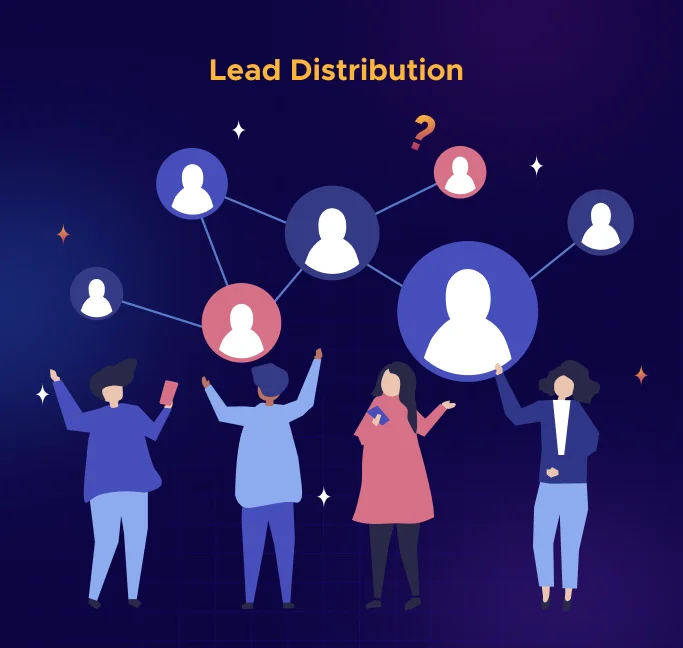
Even the best leads fail when they go to the wrong salesperson. That’s why you need a smart system to send leads to the right salesperson.
How to distribute the leads the right way:
Round-Robin: It means giving leads to salespeople one by one, in a fixed order. It keeps things fair; everyone gets an equal number of leads.
For example, if you have 5 salespeople, each one gets a lead in turn. After the 5th Salesperson, it goes back to Salesperson 1st.
Based on location: Send leads to the salesperson in the same area or time zone. Why?
- They can reply faster
- They understand local challenges better
- They might even speak the same language as the lead.
Based on Skills: Send each lead to a salesperson who understands that lead’s requirement.
- If it’s healthcare leads, then send it to healthcare reps/salespeople
- If it’s technical buyers, then send it to a technical rep.
- If it’s a big company, then send it to the most experienced rep.
Based on Performance: Some leads are better at turning leads into customers.
- Top performers should get the hottest leads.
- Give new reps simple leads so they can learn and practice.
- Use the round-robin method when all reps are equally skilled.
Based on Speed: If you wait too long, the lead may lose interest. So reply fast.
- When someone fills out website forms: Reply to them within 5 minutes or less.
- If someone asks for a Demo: Respond within 1 hour.
- Someone downloads your content: Contact them the same day.
- Event leads: Contact within 48 hours max.
Note: When you send leads to the right person based on the above requirement, you can close up to 40% more deals.
Stage 5: Lead Nurturing
This step includes building and maintaining relationships with potential customers who are not yet ready to buy.
Leads who are nurtured spend 47% more and give you 20% more sales chances.
Here are a few ways to nurture potential customers that work well:
Email Nurtured campaigns:
- Webinar emails: These emails invite people to join a live or recorded class to learn something useful.
- Upgrade emails: These gently remind people to move from a free version to a paid one by showing them the extra benefits.
- Engagement emails: These emails are fun, helpful messages that keep people interested. It could be tips, stories, or even jokes.
- FAQ Emails: These emails answer common questions people ask before buying, to make them feel more confident and safe.
Multi-channel Nuturing:
- Re-targeting ads
- Social Media
- Phone calls
- Custom landing pages
- SMS or WhatsApp messaging
Stage 6: Lead Conversion
Next is our final lead conversion stage, where our leads are convinced to pay for our services or products. At this point, the sales team uses different methods to close the deals, and here are the conversion tips that work:
1. Use a Multi-step sales approach:
- First call: Carefully listen and let the other person speak more.
- Demo: Show how your products solve their problems.
- Proposal: Customize it to fit their requirement.
- Negotiation: Sell value, not discounts
2. Follow up with leads who aren’t ready yet (post-SQL Nurturing):
Not everyone buys immediately. Therefore, keep them engaged by:
- Checking in monthly with some useful resources.
- Give early access to new features.
- Inviting them to exclusive customer events.
Stage 7: Analysis and Optimization
The lead management process doesn’t end with conversion. To keep growing, you need to keep checking what’s working and what’s not. That’s how you build a strong process that brings consistent results.
This is what our final step, Analyzing and Optimization, is. We review what’s working, fix what’s not, and keep improving the process for better results.
Below are the Key Metrics to Track:
1. Volume Metrics
- Where are your leads actually coming from?
- What percentage makes it from MQL (Marketing Qualified Leads) to SQL?
- How many SQLs (Sales Qualified Leads) become opportunities?
- Which source brings the most wins?
2. Velocity Metrics
- How fast do leads become MQLs?
- How fast do MQLs become SQLs?
- How long does it take to close a deal?
- Where do deals get stuck?
3. Value Metrics
- How much money does a customer bring in over time?
- What is the cost of acquiring a customer through each channel?
- How much revenue do you get from each lead?
- Are you making a good return from each marketing effort?
Benefits of an Effective Lead Management Process
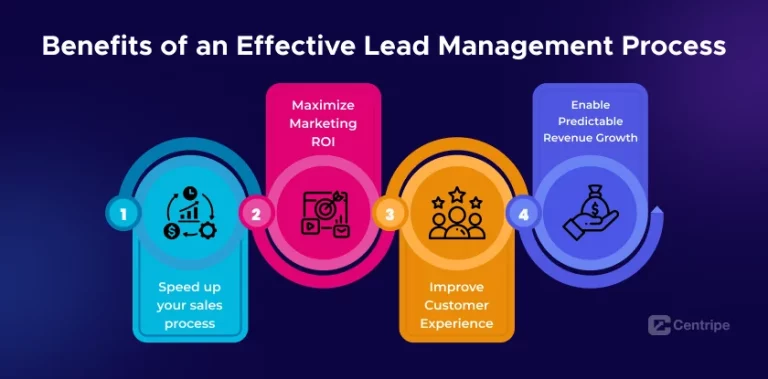
Businesses that follow a strong lead management process generate better leads and easily convert them into customers.
Let’s see those benefits below:
1. Speed up your sales process:
Salespeople only spend about one-third of their time actually selling.
And the rest of the time? They are talking to people who are not serious or can’t decide.
A good lead management process helps them by sending the right people, those who are ready to buy.
2. Maximize Marketing ROI:
With a strong lead management process, you can track every step right from when someone visits your website to when they finally say yes. Therefore, there’s no need to guess what’s working.
Now you can easily know exactly which actions bring leads and which ones don’t. It means you can invest your time in what’s working.
3. Improve Customer Experience:
Today’s B2B buyers prefer to learn about a product independently before consulting a salesperson.
A good lead management system helps you share helpful information with them while they are still deciding. This builds trust and makes it easier for them to choose you.
4. Enable Predictable Revenue Growth:
When you have clear steps and know your conversion numbers, you can actually predict your revenue.
With the help of the lead management process, sales start to work with a clear, simple, and step-by-step plan.
Conclusion
And there you have it! We’ve walked through the 7 essential steps of lead management, from finding curious visitors to turning them into loyal customers.
It’s time to put it to work.
Start with small fixes, clean up your forms, follow up faster, and make sure every lead lands with the right person.
Because here’s the truth: leads don’t get lost because they’re bad, they get lost because the process is broken.
If you are losing leads, you are losing money every single day.
So, fix the process… and the results will follow.
